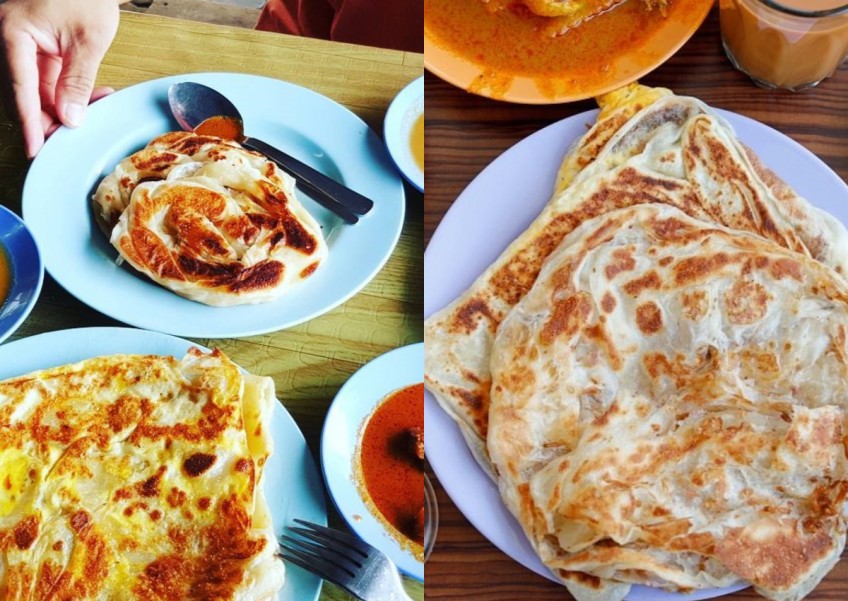Are roti prata and roti canai the same? Food guide explains difference after suggesting it's the same thing


 PUBLISHED ONSeptember 15, 2023 7:35 AMByMelissa Teo
PUBLISHED ONSeptember 15, 2023 7:35 AMByMelissa Teo A few days back, experiential online guide TasteAtlas crowned Malaysia's roti canai as the best-rated bread in the world.
However, under their list of recommended places to get good roti canai, the top spot belonged to Singapore's Mr and Mrs Mohgan, which sells roti prata.
The terms roti prata and roti canai are sometimes used interchangeably but are they really the same thing?
In a separate article by TasteAtlas on Sept 12, they clarified that the two dishes are actually not the same.
"After TasteAtlas released the ranking of the world's best breads, in which Malaysian roti canai takes the first position (rating 4.9), and Singaporean roti prata ranks twelfth (4.6), many laughed, claiming that it’s the same dish," they shared.
"Even Wikipedia claims so! Well, it’s not."
The article went on to explain that while the two bread dishes appear to be similar, they have their own "unique identities" that stem from their distinct origins and preparation methods in the two Southeast Asian countries.
This is despite both breads having roots in the Indian subcontinent.
"Both dishes have their origins in the Indian paratha, a versatile and beloved flatbread," explained TasteAtlas, adding that both roti canai and roti prata are similarly made by layering and folding the dough multiple times.
TasteAtlas said for roti canai, which hails from Malaysia, the origins of "canai" are a matter of debate as some attribute it to Chennai, India, which others think that it originates from the Malay term which means "to knead".
"There is also speculation that it may have derived from 'chana', the North Indian dish featuring chickpeas in gravy, often paired with a similar style of bread," the food guide explained, while pointing out that roti canai itself ironically cannot be found in India.
On the other hand, the name of Singapore's roti prata is believed to have been derived from two languages — Sanskrit and Malay.
'Roti' is a term of Indian origin which broadly refers to bread or flatbread, while 'prata' means flat or thin in Malay.
Beyond the difference in the origin of the two bread dish names, the preparation method and ingredients vary as well, shared TasteAtlas.
For roti canai, the dough is kneaded with ghee (clarified butter) before being flattened, folded and fried. The result is a crispy exterior with a soft, flaky texture which is then served with a variety of curries.
And then we have roti prata, of which the dough is typically made with a combination of flour, water, sugar and condensed milk.
"This results in a slightly sweet taste and a denser, chewier texture compared to roti canai," said the food guide, adding that roti prata is also known for its paper-thin layers which are achieved through the stretching and tossing of the dough.
Instead of just curries, roti prata is served with sweet accompaniments too, like sugar.
Some Singaporeans reading this may be scratching their heads and wondering if roti prata is really made with condensed milk.
Apparently, it may be.
According to Roots, a Singapore government platform that shares more about our culture and history, the standard ingredients used to make roti prata are flour, egg, salt, water, ghee, condensed milk, and sugar.
[[nid:646207]]
Back in 2020, food blogger Dr Leslie Tay, also known as ieatishootipost, tried his hand at flipping his own roti prata at home to pass time during the Covid-19 pandemic.
But he initially found himself a little stuck because not many roti prata experts share much about the dish online.
"I cannot find a single resource on the internet that gives you everything you need to know in order to create roti prata/canai," he had written on his blog.
After speaking to several "prata men" and studying prata flipping videos, he learned that the ingredients used to make prata are plain flour, water, condensed milk, oil or melted butter, salt and an egg.
But if you want a "leaner" prata dough (with a crisper texture), you can substitute the condensed milk with sugar instead.
He shared that the condensed milk "adds a nice caramel flavour and sweetness to the prata" while tenderising the dough and caramalising the dish.
Leslie also revealed that in a conversation with a past patient, who hails from South India, he learned that while roti prata does exist in India, it's only a small part of South India, predominantly in Chennai.
"Over there, this dish is simply called prata. Indian migrants brought this dish to Malaya where it became known as roti prata," he explained.
"The Malaysians, however, named this dish roti canai which means the 'roti' (bread) from Chennai."
ALSO READ: Cooking blog calls roti prata 'Asian flat croissant', triggers Asians
melissateo@asiaone.com
No part of this story or photos can be reproduced without permission from AsiaOne.